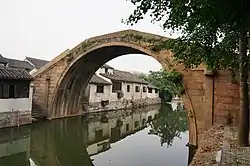Hongji Bridge 洪济桥 | |
|---|---|
 Hongji Bridge in June 2014. | |
| Coordinates | 30°52′51.96″N 120°25′41.16″E / 30.8811000°N 120.4281000°E |
| Crosses | Dongshi River |
| Locale | Nanxun, Huzhou, Zhejiang, China |
| Characteristics | |
| Design | Arch Bridge |
| Material | Stone |
| Total length | 28 metres (92 ft) |
| Width | 3.5 metres (11 ft) |
| Height | 7.2 metres (24 ft) |
| History | |
| Construction start | 1805 |
| Construction end | 1805 |
| Opened | 1805 |
| Location | |
The Hongji Bridge (simplified Chinese: 洪济桥; traditional Chinese: 洪濟橋; pinyin: Hóngjì Qiáo) is a historic stone arch bridge over the Dongshi River in Nanxun, Huzhou, Zhejiang, China.[1]
History
The bridge was first mentioned in the Prefecture Topography of Huzhou (Chinese: 湖州府志) during the reign of Wanli Emperor in the Ming dynasty (1368–1644). In 1805, in the ruling of Jiaqing Emperor of the Qing dynasty (1644–1911), it was rebuilt by local people. On November 15, 1937, in order to stop the attack of the Imperial Japanese Army, the National Army blew up part of the bridge deck.
Architecture
The bridge measures 28 metres (92 ft) long, 3.5 metres (11 ft) wide, and approximately 7.2 metres (24 ft) high.
References
This article is issued from Wikipedia. The text is licensed under Creative Commons - Attribution - Sharealike. Additional terms may apply for the media files.